In January 2024, Elena Sadiku took over as new Celtic manager following Fran Alonso’s departure to the NWSL for the Houston Dash.
As things stand, Elena Sadiku has Celtic on the verge of winning their first league title in their history; with only two games left to go, they are level on points but ahead on goal difference to cross-city rivals Rangers.
Elena Sadiku’s playing career was cut short at the age of 24, having suffered recurring injuries. However, since then, she has embarked on her managerial career. She started as an assistant manager in China for Beijing BG Phoenix before becoming current Arsenal manager Jonas Eidevall’s assistant manager at Rosengard. A short stint as head coach for Eskilstuna United was followed by a role as U21 head coach at Everton. This held her in good stead to be offered the Celtic job.
In this tactical analysis, we will provide some analysis of the key tactics that have helped Celtic succeed under Sadiku. The scout report will look at the formation, in and out-of-possession principles, and approach to transitional elements that have held Celtic in good stead so far this season.
Formation
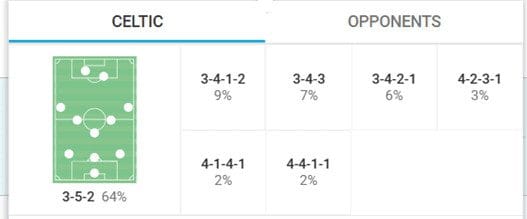
For the majority of the season under Alonso, Celtic almost exclusively used a 3-5-2 formation. However, when Sadiku came in, they used a wider range of different formations, such as trialling a 4-2-3-1 for her first game, moving towards a 3-4-3 shape, and reverting back to a 3-5-2 for their 2-1 victory over Rangers in the old firm derby in March.
We have identified that Sadiku has made small adjustments to the shape, which impact the style of play they are able to create. Let’s look at how this has affected their ability to develop attacks. We will do this by comparing the number of positional attacks against the number of counterattacks that ended in shots.
What you will see is that their style of play has not significantly changed either, and although the number of positional attacks has decreased from 46.00 to 36.64, this can be attributed in part to the difference in opponents that Sadiku has faced, given how the Scottish league splits around March into a championship and a relegation group.
Despite the number of positional attacks decreasing, the actual ratio of positional attacks to counterattacks has stayed relatively constant. Only the volume of attacks earlier in the season has changed.
In addition, their value for efficiency of these attacks, attacks ending in shots, has also not significantly changed, moving from 31% down to 27% under Sadiku. This is not a significant enough leap to suggest any deficiency, particularly considering the increased difficulty of opposition.
Having demonstrated that their statistical numbers haven’t significantly wavered with the side essentially performing in a similar style to before, let’s take a look at what Sadiku has been able to do that has put Celtic in pole position to win the first-ever SWPL title.
In Possession
In terms of goal production, Celtic have averaged 3.71 goals per game, exceeding their expected rate of 1.78. This has resulted in Celtic scoring the most goals in the division this season, which at present is the difference between them and Rangers on the league table, with a 15-goal advantage on goal difference, having scored 122 goals to Rangers’ 106.
When building up from the back, Celtic looks to stretch the field as wide as possible with their 3-4-3 shape. However, one of the most noticeable characteristics is that although the number of passes has dropped under the passing reign from 494.41 to 478.27. The proportion of forward passes has actually increased, with Saliku’s Celtic now averaging 2.21 forward passes for every backward pass.
A further characteristic of Saliku’s Celtic possession is their ability to vary their attacking style, with them comfortable playing out from the back in a more methodical manner where they generally look to play around the opposition shape and compress wide areas. Equally, though they are comfortable playing quicker, more direct football to isolate space and stretch opponents. This gives them a real balance, which can beat you in multiple ways.
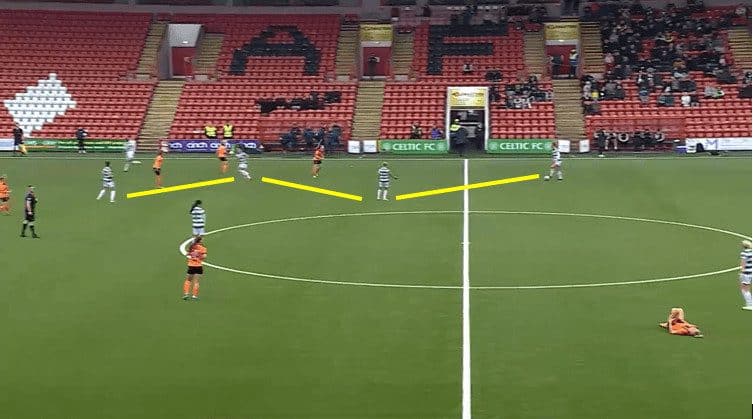
Here, Celtic is taking a more patient approach, with the backline spread wide across the field, while the rest of the Celtic players in possession have compressed the wide channel.
In addition to condensing the wide channel with players, the players are also stationed in a Z-shape, which enables them to make efficient short passes to help break down the opposition’s shape.
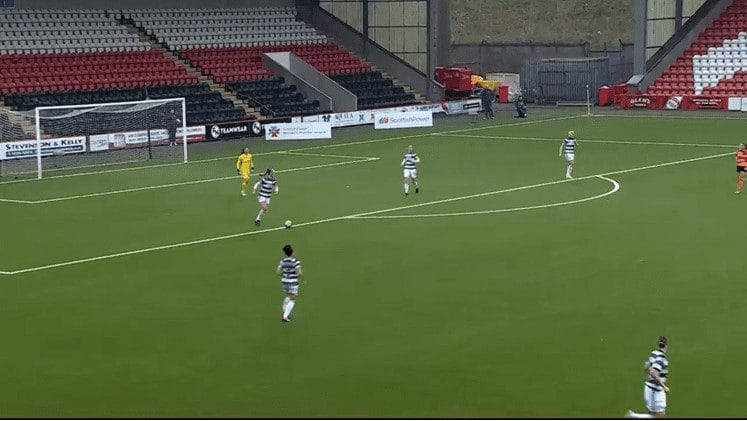
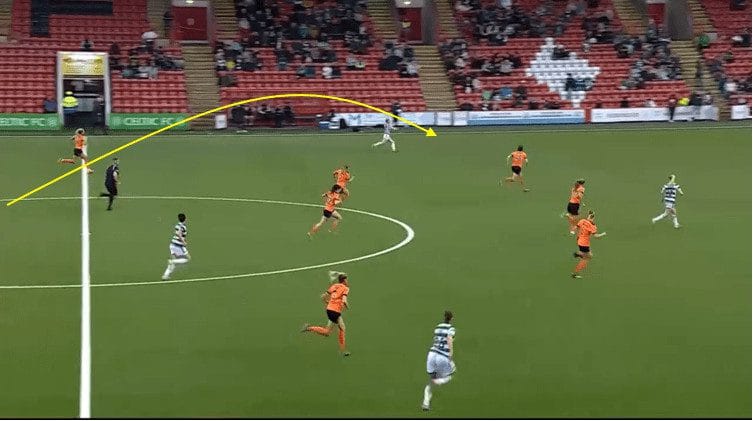
In this example, you have the typical back three shape with the ball with Caitlin Hayes. You can clearly see the back three shapes, with the fullback pulling wide. However, unlike the previous example, where Celtic played around the Glasgow City shape, this time, they play a long diagonal ball for Lucy Ashworth-Clifford to chase.
This enables Celtic to bypass the entire Glasgow City midfield and stretch the opposition vertically while also isolating the space in the wide channels for the Glasgow defenders to have to cover.
Now, having looked at how Celtic move the ball up the field, another area in which Celtic have demonstrated significant levels of quality is in their ability to enter the box. Most notably again here is their balance and ability to do so in several different ways. Demonstrating the ability to play through the middle with through balls and effective combination play. Alternatively, through wide play and crossing behind the opposition’s defensive line.
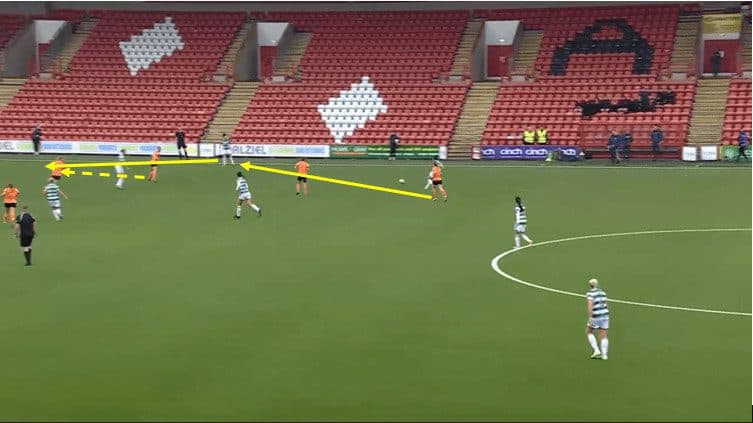
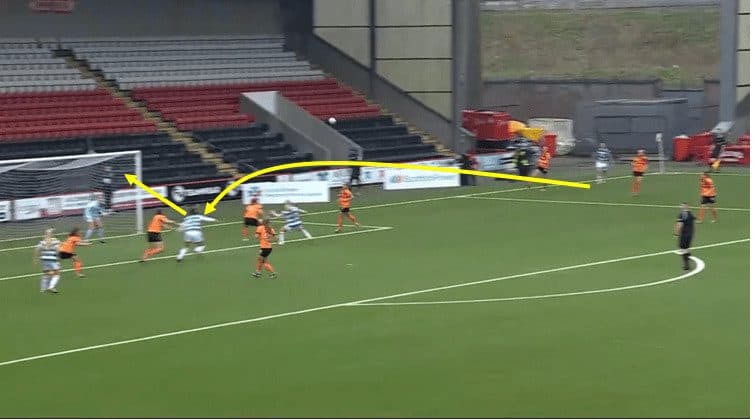
In this example, Celtic simply play around the opposition shape by creating a wide triangle. A smart run into the wide channel by Natasha Flint is able to isolate the defender one-on-one and enables Flint to play a cross towards Hayes in the box, who is able to head home for the goal.
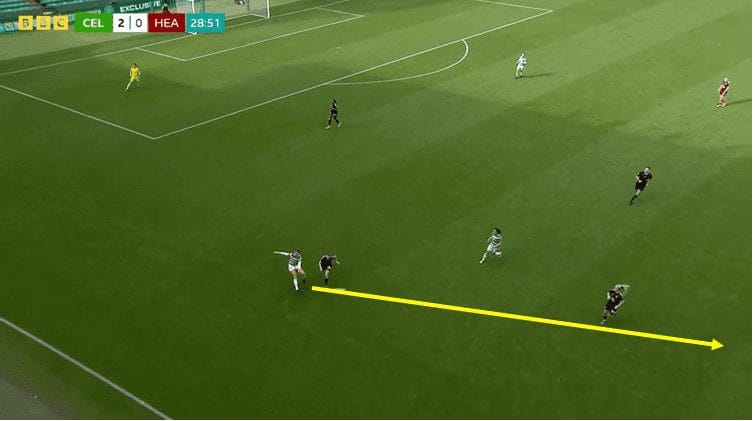
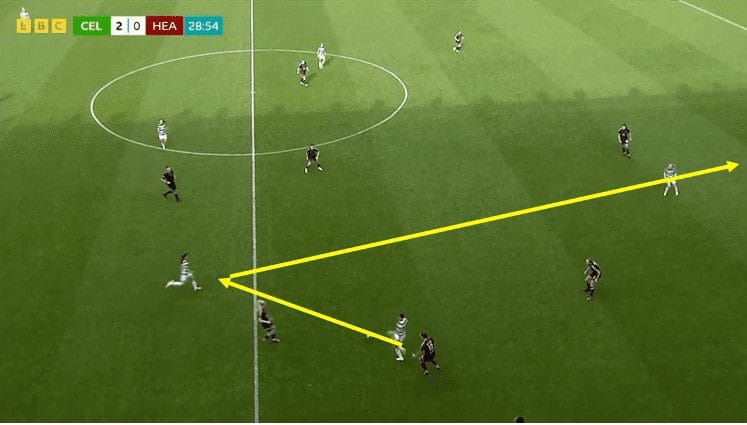
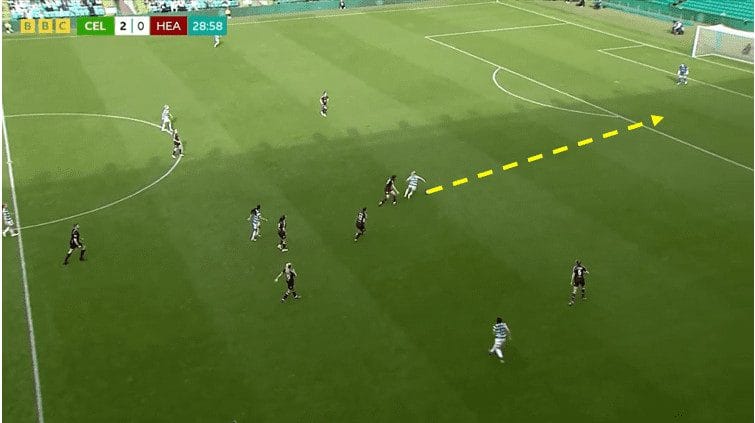
In this example here, you have Celtic with the ball at the back. They then execute a typical up, back and through to break down the Hearts shape. Hayes playing a forward ball to Flint with her back to the goal. Before Flint drops the ball off towards the onrushing midfielder Shen Mengyu, who is able to play Murphy Agnew in behind the defence and through one-on-one with the goalkeeper.
Out of Possession
Another vital aspect of Celtic’s success so far this season has been their defensive output. Under Sadiku’s reign, they conceded 0.73 goals per 90 minutes but only 8.45 shots per 90 minutes. As a rule, Celtic looks to defend on the front foot and is aggressive in the press, which enables them to generate a number of high regains, which can lead to high-quality goal-scoring opportunities.
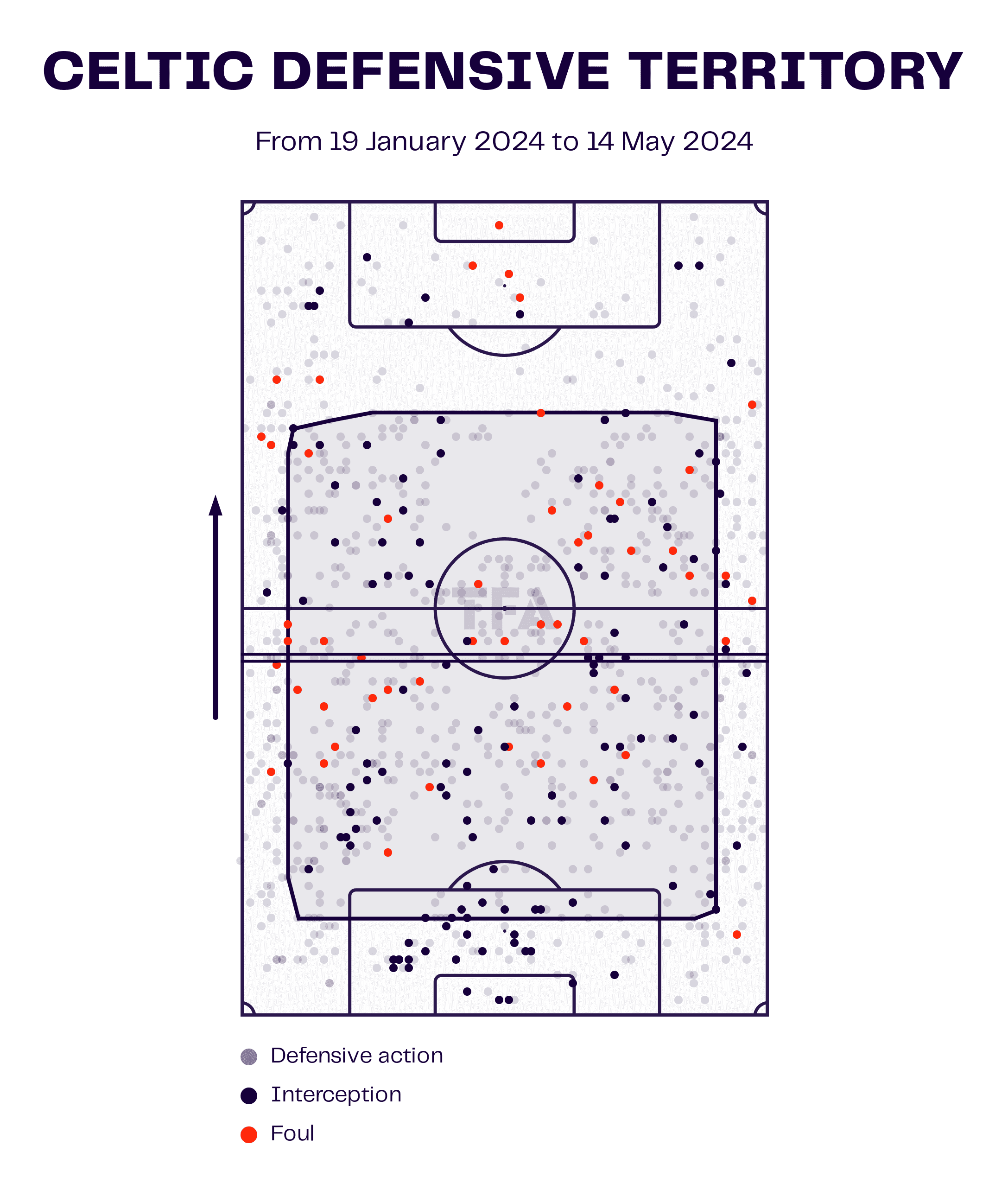
Most notably, despite playing largely against stronger opposition, the number of regains has risen to 93.76 per 90, with 20.3% of those regains being high regains. What you will notice is that they have operated a high defensive line for large parts of the season.
Throughout the season, Celtic have had the highest challenge intensity, number of duels, tackles, and interceptions per minute of opponent possession, with 7.6. What is perhaps most impressive about this is how under Sadiku, the intensity has risen even further, with the Celtic side averaging 76.18 defensive duels per 90, a 9.29 increase from earlier on in the season. In addition to the number of defensive challenges increasing, so has the number of interceptions per 90, rising from 36.25 to 41.45.
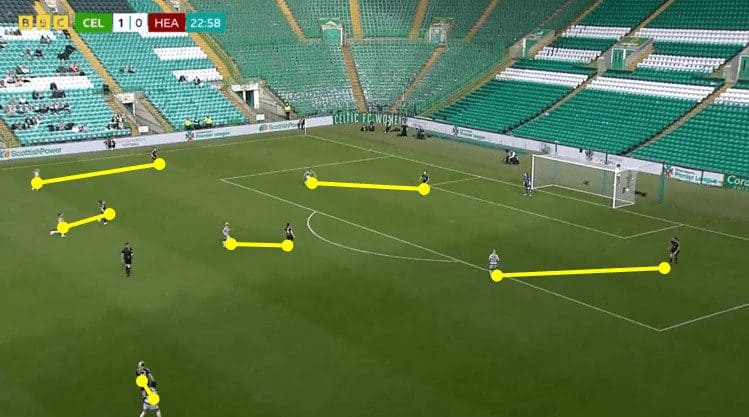
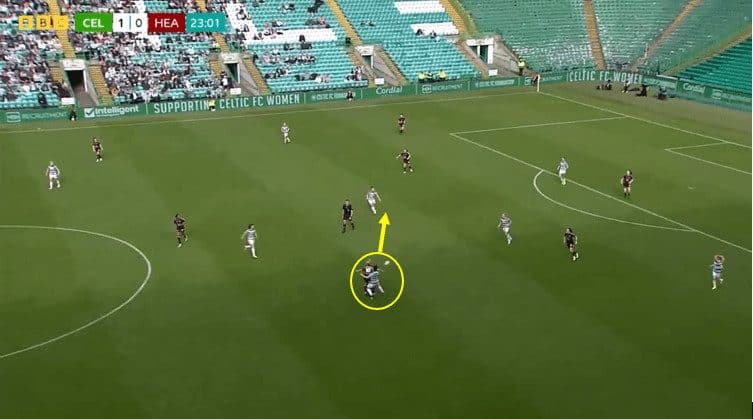
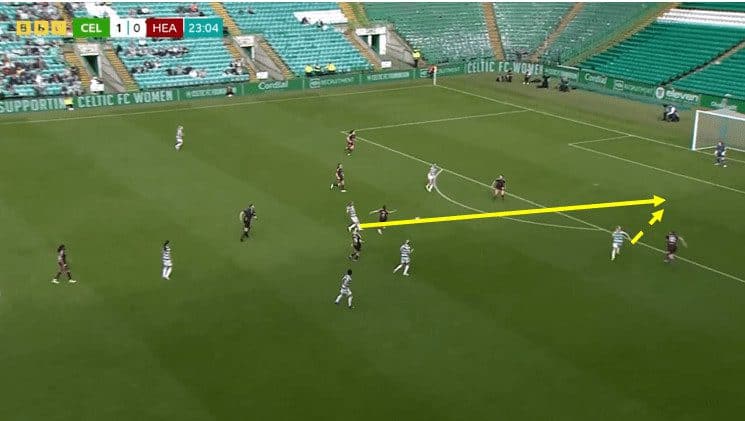
In this example, Hearts look to play out from the back what can instantly be seen is how Celtic are able to create one-on-one matchups all over the field. This forces Hearts to play a longer ball towards the front line.
Celya Barclais is able to step in and win her one-on-one matchup and launch a dangerous attack for Celtic. With one through ball, Agnew is played through on goal and is able to finish off the move for a goal.
Generally Celtic have been able to assert dominance over their opposition and control the territory game with their relentless press. However, against more equal opposition such as Rangers, Celtic have demonstrated some ability to create a solid defensive structure to limit opportunities in the box.
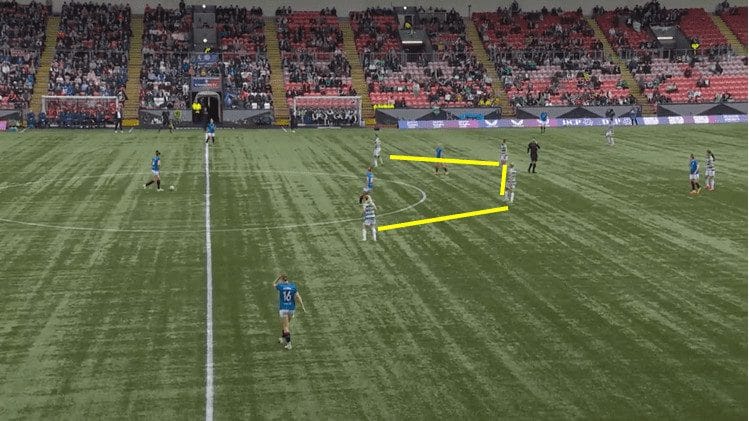
In this example here from the 0-0 draw against Rangers, Celtic are almost playing a 5-1-4 shape with Shen Mengyu playing as the deeper midfielder. Playing behind a box-four of Flint and Agnew, typically the two centre forwards have split and are defending as wingers. The other two midfielders that you have are Amy Gallacher and Natalie Ross blocking up the centre of the field.
One of the issues with this shape is it does leave space on either side of Mengyu and could leave her isolated if opponents drop deeper into the half-spaces. However, this is where the back three really comes into its own as the centre-backs are tasked with tracking opponents and tightly marking any attacker to drop into the half-spaces. The back three enabled Celtic to cover a larger amount of the field while also having the numbers to still cover the space in behind.
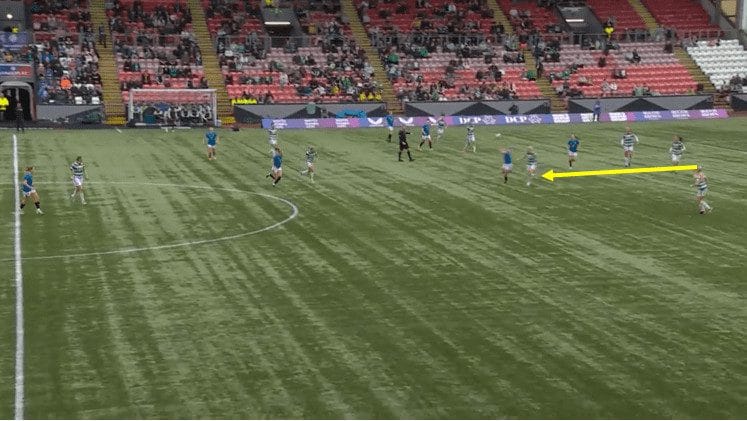
In this example, the Rangers forward drops into the space between the lines. Craig Ross tracks this run and prevents her from being able to turn and progress the attack.
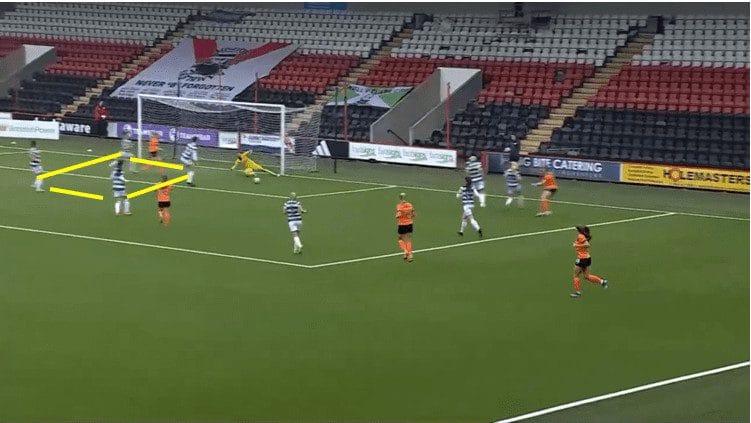
Then, when opponents may get into dangerous positions in the final third, Celtic’s shape enables them to defend the box confidently. With them able to put three players into the wide channel to try and block the cross while four central players are able to create the numerical strength in the box to prevent balls.
It is also important to note that it’s not a flat defensive line. You have to have defenders with two midfielders slightly advanced of them. This limits the space in the box for opponents to find and eliminates the opportunity for a cutback ball.
Transitions
A further key aspect to Celtic’s success this term has been their strength in transition. Having already demonstrated how they can control the other phases of the game, let’s take a look at how they deal with the most chaotic phase in football.
With them controlling the possession for on average of 64.3% of the game, opponents are looking to sit back and try to hit them on the counterattack. As a result, their ability to remain solid in their rest defence is going to be a vital component of the side.

The most common rest defence shape for the Celtic is a 3-3 shape, with the three centre-backs offering the last line of the defence. The sole midfielder could become isolated with the two wing-backs remaining wide throughout. This could leave spaces for opponents to attack. This makes it all the more important for the back three to be able to cover the entire field. Their primary role is to delay the opposition and allow their teammates to get back into shape.
In defence-attack transition, Celtic’s outlets are the wingbacks and most commonly it is Ashworth-Clifford down the left flank.
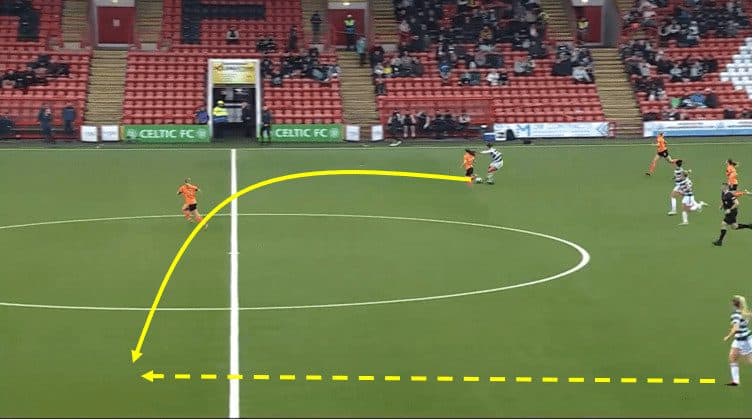
Having won the ball back in the box, Hayes can drive forward with it. However, she always has her head up, looking for this switch ball towards Ashworth-Clifford on the left, who is able to attack the space around her and progress the counterattack.
Conclusion
Having built on the success that Fran Alonso was already able to create over the past four years. Sadiku has been able to put the Celtic side on the verge of creating history with three games to go in the league and leading their nearest competitors, Rangers, as they go into their final two games of the season by fifteen goals on goal difference.






Comments